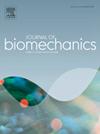Joint moment–angle/velocity relations in the hip, knee, and ankle: A meta-visualization of datasets
IF 2.4
3区 医学
Q3 BIOPHYSICS
引用次数: 0
Abstract
Joint moment is a prominent kinetic property in biomechanical investigations, whose pattern and magnitude reflect many characteristics of musculoskeletal motion and musculotendon biomechanics. Nonetheless, the relations of joint moment with joint angle and velocity are complicated, and it is often unclear how the kinetic capacity of each joint varies in different configurations. With common techniques in systematic review, we collected a total of 962 passive, isometric and isokinetic joint moment datasets based on human in vivo measurements from literature and visualized the major joint moment–angle and moment–velocity relations in the hip, knee, and ankle. The findings contribute to the analysis of musculoskeletal mechanics and providing reference regarding the experimental design for future moment measurement.
髋关节、膝关节和踝关节的关节力矩-角度-速度关系:数据集的元可视化。
本文章由计算机程序翻译,如有差异,请以英文原文为准。
求助全文
约1分钟内获得全文
求助全文
来源期刊

Journal of biomechanics
生物-工程:生物医学
CiteScore
5.10
自引率
4.20%
发文量
345
审稿时长
1 months
期刊介绍:
The Journal of Biomechanics publishes reports of original and substantial findings using the principles of mechanics to explore biological problems. Analytical, as well as experimental papers may be submitted, and the journal accepts original articles, surveys and perspective articles (usually by Editorial invitation only), book reviews and letters to the Editor. The criteria for acceptance of manuscripts include excellence, novelty, significance, clarity, conciseness and interest to the readership.
Papers published in the journal may cover a wide range of topics in biomechanics, including, but not limited to:
-Fundamental Topics - Biomechanics of the musculoskeletal, cardiovascular, and respiratory systems, mechanics of hard and soft tissues, biofluid mechanics, mechanics of prostheses and implant-tissue interfaces, mechanics of cells.
-Cardiovascular and Respiratory Biomechanics - Mechanics of blood-flow, air-flow, mechanics of the soft tissues, flow-tissue or flow-prosthesis interactions.
-Cell Biomechanics - Biomechanic analyses of cells, membranes and sub-cellular structures; the relationship of the mechanical environment to cell and tissue response.
-Dental Biomechanics - Design and analysis of dental tissues and prostheses, mechanics of chewing.
-Functional Tissue Engineering - The role of biomechanical factors in engineered tissue replacements and regenerative medicine.
-Injury Biomechanics - Mechanics of impact and trauma, dynamics of man-machine interaction.
-Molecular Biomechanics - Mechanical analyses of biomolecules.
-Orthopedic Biomechanics - Mechanics of fracture and fracture fixation, mechanics of implants and implant fixation, mechanics of bones and joints, wear of natural and artificial joints.
-Rehabilitation Biomechanics - Analyses of gait, mechanics of prosthetics and orthotics.
-Sports Biomechanics - Mechanical analyses of sports performance.
 求助内容:
求助内容: 应助结果提醒方式:
应助结果提醒方式:


